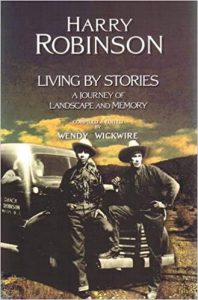For this lesson I decided to answer question 5 which is asking me to compare Harry Robinson’s “Coyote Makes a Deal with the King Of England” with King’s Green Grass, Running Water. In this blog post I will first discuss the differences in writing style between the two authors and then move on to talk about the power dynamics of Coyote and God in each story.
In the question the professor gives a quote by Blanca Chester that explains how Robinson’s literature has had a huge impact on the way King writes. Blanca Chester’s (46) quote explains that Robinson’s literature has caused King to make changes in the way he writes dialogue, addresses readers and characters, chooses characters (for example adopting characters from Indigenous cultures) and connects his story lines (as cited by Paterson Lesson 3.1). After I read part one of King’s book Green Grass, Running Water I agreed with most of what Chester says, as I can see many similarities in both Robinson’s and King’s literature. I see similarities when it comes to the unique role of narrator being able to communicate with the characters and/or with the readers and the using characters form Indigenous cultures and Christianity. One thing that stood out to be a little bit more complicated to me was the amount and the extent that oral syntax was used by both writers. It is explained on a Wikipedia page for Green Grass, Running Water that King “has been hailed as a merger between oral and written tradition” (Green Grass, Running Water Wikipedia) and although I do agree with this statement I do feel that King has not preserved the oral tradition of the story to the same extent that it is preserved in Robinson’s book. In Robinson’s stories the reader is almost forced to have to read the stories out loud because Wickwire writes in a way that uses oral syntax and imitates human speech. In King’s Green Grass, Running Water there is some of this oral syntax present however it is only used in some of the story lines and is not used to the same extent that Wickwire used it.
Now I will move on to talk about how Coyote and God are represented in Robinson’s and King’s story and the interesting power dynamic between them. In Robinson’s story “Coyote Makes a Deal with the King Of England” God sends down an Angel to Coyote and it is explained that the Angel says to Coyote that “God says at one time you work for him… But now God sent me here to hire you again, just for a short time.” (Robinson). In this situation it feels like Coyote is working for God, and God is represented as more powerful as Coyote. What I find really interesting is that in King’s story God and Coyote have a completely different power dynamic. For example in the beginning of the story Coyote in a way creates GOD as GOD comes from one of Coyote’s dreams (King). Coyote at first says to the dream that the dream should be a dog as “Dogs are good. They are almost as good as Coyote” (King) I feel this somewhat represents that Coyote is more powerful than GOD. However, there is more to this relationship as throughout the story GOD and Coyote talk to each other like they are on the same level. What is also really interesting is how GOD is portrayed in King’s novel. CanLit GUIDES talks about the key themes of Green Grass, Running Water and cites Goldman explaining that in the story God is casted as “one of Coyote’s dreams that’s become egocentric and egotistical” (as cited in CanLit GUIDES). I totally agreed with this interpretation as I felt that in the story GOD was often acting selfish and bossy, for example he would not let others share his food in the garden and his excuse for this was it was against “Christian rules” (King). I have been thinking about why these two stories would portray the power relationship between Coyote and God so differently, and I have a few theories but nothing developed enough yet that I would be able to share. If people reading this blog have any theories to why the power relationship is so different I would love to here it!

citations
Cooper, Guy H. “Coyote in Navajo Religion and Cosmology.” Canadian Journal of Native Studies , 1987, pp. 181–193.
“Green Grass, Running Water.” Wikipedia, Wikimedia Foundation, 18 Apr. 2019, en.wikipedia.org/wiki/Green_Grass,_Running_Water#Merging_oral_and_written_tradition.
“Key Themes.” CanLit Guides, 22 Nov. 2013, canlitguides.ca/canlit-guides-editorial-team/green-grass-running-water-by-thomas-king/key-themes/.
King, Thomas. Green Grass, Running Water. HarperCollins e-Books, 2016.
Paterson, Erika. “Lesson 2:2.” English 372 99C Canadian Studies, blogs.ubc.ca/engl372-99c-2019wc/unit-2/lesson-2-2/.
Robinson, Harry. Living by Stories: a Journey of Landscape and Memory. Ed. Wendy Wickwire. Vancouver: Talonbooks, 2005. e-book.
Rose, Marion. “Moon Talk – Coyote by Marion Rose.” Fine Art America, fineartamerica.com/featured/moon-talk–coyote-marion-rose.html.

